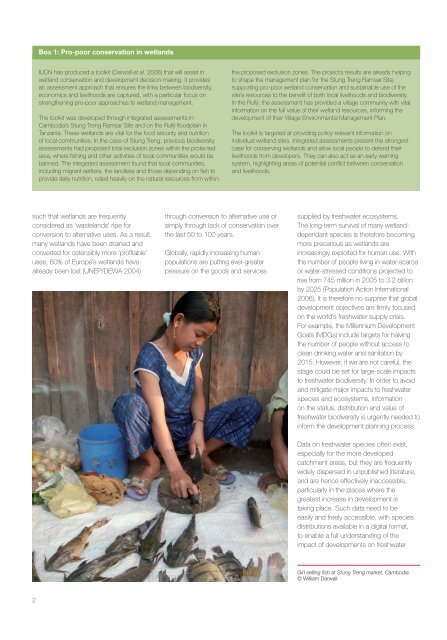Freshwater Biodiversity – a hidden resource under threat - IUCN
Freshwater Biodiversity – a hidden resource under threat - IUCN
Freshwater Biodiversity – a hidden resource under threat - IUCN
You also want an ePaper? Increase the reach of your titles
YUMPU automatically turns print PDFs into web optimized ePapers that Google loves.
such that wetlands are frequently<br />
considered as ‘wastelands’ ripe for<br />
conversion to alternative uses. As a result,<br />
many wetlands have been drained and<br />
converted for ostensibly more ‘profi table’<br />
uses; 60% of Europe’s wetlands have<br />
already been lost (UNEP/DEWA 2004)<br />
2<br />
Box 1: Pro-poor conservation in wetlands<br />
<strong>IUCN</strong> has produced a toolkit (Darwall et al. 2008) that will assist in<br />
wetland conservation and development decision-making. It provides<br />
an assessment approach that ensures the links between biodiversity,<br />
economics and livelihoods are captured, with a particular focus on<br />
strengthening pro-poor approaches to wetland management.<br />
The toolkit was developed through integrated assessments in<br />
Cambodia’s Stung Treng Ramsar Site and on the Rufi ji fl oodplain in<br />
Tanzania. These wetlands are vital for the food security and nutrition<br />
of local communities. In the case of Stung Treng, previous biodiversity<br />
assessments had proposed total exclusion zones within the protected<br />
area, where fi shing and other activities of local communities would be<br />
banned. The integrated assessment found that local communities,<br />
including migrant settlers, the landless and those depending on fi sh to<br />
provide daily nutrition, relied heavily on the natural <strong>resource</strong>s from within<br />
through conversion to alternative use or<br />
simply through lack of conservation over<br />
the last 50 to 100 years.<br />
Globally, rapidly increasing human<br />
populations are putting ever-greater<br />
pressure on the goods and services<br />
the proposed exclusion zones. The project’s results are already helping<br />
to shape the management plan for the Stung Treng Ramsar Site,<br />
supporting pro-poor wetland conservation and sustainable use of the<br />
site’s <strong>resource</strong>s to the benefi t of both local livelihoods and biodiversity.<br />
In the Rufi ji, the assessment has provided a village community with vital<br />
information on the full value of their wetland <strong>resource</strong>s, informing the<br />
development of their Village Environmental Management Plan.<br />
The toolkit is targeted at providing policy-relevant information on<br />
individual wetland sites. Integrated assessments present the strongest<br />
case for conserving wetlands and allow local people to defend their<br />
livelihoods from developers. They can also act as an early warning<br />
system, highlighting areas of potential confl ict between conservation<br />
and livelihoods.<br />
supplied by freshwater ecosystems.<br />
The long-term survival of many wetlanddependant<br />
species is therefore becoming<br />
more precarious as wetlands are<br />
increasingly exploited for human use. With<br />
the number of people living in water-scarce<br />
or water-stressed conditions projected to<br />
rise from 745 million in 2005 to 3.2 billion<br />
by 2025 (Population Action International<br />
2006), it is therefore no surprise that global<br />
development objectives are fi rmly focused<br />
on the world’s freshwater supply crisis.<br />
For example, the Millennium Development<br />
Goals (MDGs) include targets for halving<br />
the number of people without access to<br />
clean drinking water and sanitation by<br />
2015. However, if we are not careful, the<br />
stage could be set for large-scale impacts<br />
to freshwater biodiversity. In order to avoid<br />
and mitigate major impacts to freshwater<br />
species and ecosystems, information<br />
on the status, distribution and value of<br />
freshwater biodiversity is urgently needed to<br />
inform the development planning process.<br />
Data on freshwater species often exist,<br />
especially for the more developed<br />
catchment areas, but they are frequently<br />
widely dispersed in unpublished literature,<br />
and are hence effectively inaccessible,<br />
particularly in the places where the<br />
greatest increase in development is<br />
taking place. Such data need to be<br />
easily and freely accessible, with species<br />
distributions available in a digital format,<br />
to enable a full <strong>under</strong>standing of the<br />
impact of developments on freshwater<br />
Girl selling fi sh at Stung Treng market, Cambodia.<br />
© William Darwall

















